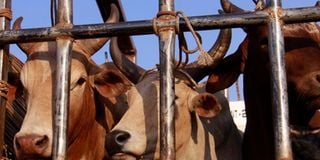Premium
Meat prices soar as foot-and-mouth disease hits North Rift livestock markets

Meat prices soar as foot-and-mouth disease hits North Rift livestock markets.
What you need to know:
- Traditionally North Rift is one of Kenya's major meat-producing areas.
- The quarantine has severely disrupted livestock trade in the region.
A severe outbreak of foot-and-mouth disease (FMD) has forced authorities to impose strict quarantine measures across four counties, leading to the closures of tens of livestock markets.
This now threatens Kenya's meat supply chain.
The outbreak comes as the government prepares to launch an ambitious nationwide vaccination campaign targeting 22 million cattle and 50 million goats beginning next week.
The highly contagious viral disease, which affects cloven-hoofed animals including cattle, sheep, and goats, has been confirmed in Trans Nzoia, Nandi, Kakamega and West Pokot counties.
According to the Directorate of Veterinary Services Dr Allan Azegele, the virus spreads rapidly through direct contact between animals and can also be transmitted through contaminated equipment and vehicles.
"FMD is particularly challenging to contain because of its high transmission rate," explained Dr Azegele.
The quarantine has severely disrupted livestock trade in the region, traditionally one of Kenya's major meat-producing areas.
Joseph Lamai, Trans Nzoia County Chairman of livestock traders, reports that local meat prices have surged dramatically, with beef rising from Sh520 to Sh660 per kilo and goat meat jumping from Sh600 to Sh750.
"This disease has been affecting our operations for the past four months," says Lamai.
"The closure of West Pokot markets, our primary supply source, has forced traders to source animals from as far as Elgeyo Marakwet County, significantly increasing operational costs."
The Nation spot check
A survey of Kitale town's main slaughterhouse reveals drastically reduced activity.
Daily cattle slaughter numbers have dropped from an average of 50 to just 15 animals, according to facility records.
This 70 per cent reduction mirrors similar declines across the region's meat processing facilities.
"Infected animals develop fever, followed by blisters in the mouth and on feet. While mortality rates are generally low in adult animals, the disease causes significant production losses through reduced milk yield, weight loss, and breeding complications," explained Dr Azegele.
The current outbreak has been identified as serotype O, one of the seven known FMD virus strains. This particular strain has been responsible for 60 per cent of foot and mouth disease outbreaks in East Africa over the past decade, according to the Kenya Veterinary Services.
In response to the crisis, President William Ruto announced a nationwide vaccination program targeting 22 million cattle and 50 million sheep and goats, an announcement that was met with resistance and disapproval.
Trans Nzoia County Executive for Agriculture and Livestock, Phanice Khatundi, said the county was on high alert.
"We've mobilised veterinary and extension officers for pre-vaccination screening. The process includes animal health assessments and marking of vaccinated livestock to ensure comprehensive coverage," the county official said.
Not first outbreak
Data from the Directorate of Veterinary Services shows that Kenya has experienced three major foot and mouth disease outbreaks in the past decade.
The first was in 2018, which affected 12 counties and resulted in Sh3.2 billion in economic losses, the second in 2020 impacted eight counties and led to Sh2.1 billion in economic loss, and the latest one in 2022, that affected four counties and led to Sh900 million in losses.
The current outbreak's economic impact is still being assessed, but preliminary estimates suggest losses could exceed Sh1.5 billion if containment measures prove ineffective.
"The owner of the animal has to be honest enough and report any incident of disease so that we can intervene. We want to heighten awareness so that all the farmers are aware of what signs to look out for," Dr Azegele said.
Local businesses and consumers are developing coping strategies.
Some butcheries have diversified their offerings, introducing more chicken and fish products. Others have temporarily closed, unable to absorb the increased operational costs.
Veronica Adhiambo, a Kitale resident, represents a growing number of consumers shifting to alternative protein sources.
"I've switched to vegetables and white meat until the quarantine is lifted. The high prices and health concerns make this a prudent choice."
However, not all consumers share these concerns.
Gilbert Namaswa from Bidii area maintains his meat consumption habits.
"I understand the disease doesn't affect humans, so I'll continue eating meat despite the quarantine."
While foot and mouth disease does not affect humans, consuming meat from infected animals is not recommended.
"The quarantine measures are primarily economic rather than public health interventions," Dr Azegele says.
"Nothing will happen to you if you eat that meat or drink milk from an infected animal. But what will happen is that you will become a conduit of spread, particularly in rural areas where you probably have livestock in your home," he explained.
The outbreak's effects extend beyond immediate quarantine zones.
Neighboring counties report increased pressure on their livestock markets as traders seek alternative supply sources. Elgeyo Marakwet County has seen a 40 per cent increase in livestock prices due to heightened demand from quarantined regions.
Local authorities have been criticised for shutting down markets if foot and mouth disease poses no public health emergency.
"We acknowledge the economic hardship caused by quarantine measures," says Ms Khatundi, the Trans Nzoia Agriculture county minister. "However, these restrictions are necessary to prevent even greater losses from widespread disease transmission."






